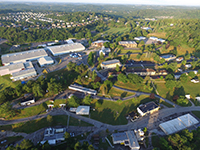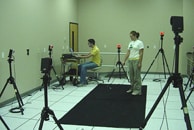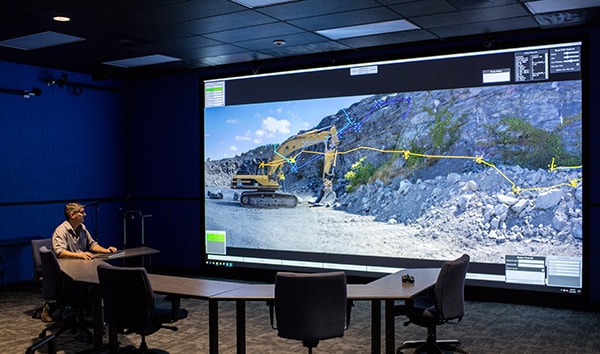Facilities
The NIOSH Mining Program’s research takes place at two sites located near Pittsburgh, Pennsylvania, and Spokane, Washington. These sites house both small and large specialized labs where researchers study heavy machinery, mechanical and electrical systems, ergonomic and biomechanic challenges, geological stresses, explosions, illumination, chemistry, dust control, and a host of other mining safety and health challenges.

Pittsburgh Site
NIOSH Mining's Pittsburgh site occupies 180 acres and serves as one of two focal points for federal mine safety and health research. The basis for the research is surveillance data and stakeholder input and the program addresses most mining sectors. Programmatic areas include dust (coal and silica) monitoring and control, mine ventilation, hearing loss prevention and engineering noise controls, diesel particulate monitoring and control, emergency response and rescue, firefighting and prevention, training research, ergonomics and machine safety, mine ground control, electrical safety, explosives safety, surveillance, and technology transfer. Major programs include:
- Health Hazards - the most significant health hazards in the mining industry include airborne contaminants such as coal dust, silica dust, diesel particulates and excessive exposure to noise levels. Pittsburgh research teams study the development of control technologies and strategies for airborne contaminants including improved measurement systems, laboratory and field studies to design, assess and demonstrate airborne hazard reduction systems. Similar work is ongoing regarding noise-induced hearing loss in mineworkers.
- Safety Hazards - while the safety record of the mining industry has improved dramatically, this occupation remains one of the more hazardous due to the nature of the work environment. Poor visibility, restricted workspaces, large machinery, significant material handling tasks and unstable ground all contribute to the hazards found in mining operations. Pittsburgh supports multi-disciplinary research to provide the technical and scientific basis for improvements in conditions, work systems and technologies.
- Disaster Prevention - due to the unique nature of underground mining operations, the potential exists for explosive gas releases, mine fires and massive roof failures. Research is ongoing to improve the understanding of the basic phenomena of mine explosions, designing explosion and fire suppression strategies, and developing approaches for minimizing or preventing massive rock failures. Researcher conduct experiments in unique laboratories such as the Mine Roof Simulator, as well as field studies in operating mines.
Spokane Site
NIOSH Mining's Spokane site serves as the second focal point for mine health and safety research. While research programs touch most mining sectors, the major program focus in Spokane is on metal and nonmetal mining. Major programmatic areas of study include:
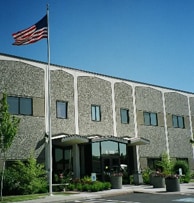
NIOSH Mining Spokane site.
- Metal Mine Ground Control - in this program, researchers develop, integrate, and promote geomechanical control strategies and technologies that reduce the risk of global and local ground failures primarily encountered in western U.S. mines. Current projects include exploring alternative mining methods in challenging environments, and developing durable roof support for underground metal mines.
- Stability and Seismic Monitoring - in this scientific area, researchers measure and characterize the rock mass response in burst-prone mines in order to better detect and prevent changing geological conditions that could pose a risk to workers in deep mines. Current projects include detecting and managing dynamic failure of near seam features in coal and nonmetal mines, and developing a real-time ground stability informatics system.
- Emerging Technologies - in this program, researchers examine how emerging technologies may affect worker health and safety. Current projects include developing a portable diesel particulate matter monitor, improving conveyor system safety, and identifying key factors affecting machine-related fatalities and injuries in the metal and nonmetal mining sectors.
- Miner Health and Chronic Disease - in this long-term and multi-disciplinary initiative, researchers study miner health and chronic disease in order to understand and hopefully ameliorate the health status and disease burden in the mine worker population. Current projects include building an evidence-based framework for improving miners' health, developing a mining fatigue model and management system, and predicting heat strain in underground metal and nonmetal mines.
Safety Structures Testing Laboratory
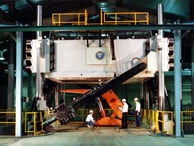
Mine roof simulator.
Location: Pittsburgh Site
The Safety Structures Testing Laboratory is dedicated to large-scale material and structural testing relating to the prevention of roof and rib falls. The focal point of the SST laboratory is the Mine Roof Simulator (MRS) biaxial load frame that simulates the extreme weight and movement of the supported overburden rock when extracting coal or other minerals from the earth.
The MRS can accommodate specimens up to 16 feet high, 20 feet wide and 20 feet long. The MRS achieves precision load testing by closed-loop, servo controlled actuators with six degrees of freedom control of the lower platen. The MRS can apply up to 3 million pounds of vertical force through the 24-inch stroke of the lower platen and, simultaneously, up to 1.6 million pounds of horizontal force through lateral displacement of the lower platen through a 16-inch stroke.
The MRS is the largest load frame of its kind in the world and is the only load frame that can simulate the complex behavior of rock masses at great depths below the surface.
Soil and Rock Properties Laboratory
Location: Spokane Site
We use the Soil and Rock Properties Laboratory to prepare, characterize, and test consolidated and unconsolidated materials. Researchers test consolidated or cemented materials and rock for various engineering properties using a suite of test frames, including a million pound compression frame, a programmable controlled tension-compression frame, and a fiber-panel testing device.
The labs large scale direct shear test frame (300,000 pound axial and shear forces) with programmable control is used for biaxial testing on rock, concrete, and soil samples. The sample size can vary from 1 inch diameter rock cores to 14 inch square concrete blocks.
Safety Research Coal Mine and Experimental Mine
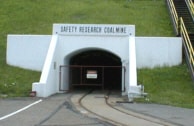
Safety research coal mine portal.
Location: Pittsburgh Site
Our Safety Research Coal Mine and Experimental Mine include four miles of underground workings in the Pittsburgh coal seam, and have been used extensively to study sensor technologies, roof bolt performance, dust control, explosions, and human performance.
The Experimental Coal Mine consists of two drift entries and the Safety Research Coal Mine is a room-and-pillar operation approximately the size of a working section. A full-time staff of miners provides technical and physical assistance to in-house and contract researchers.
Acoustic Test Chamber
Location: Pittsburgh Site
The NIOSH Acoustic Test Chamber is a very large acoustic reverberation chamber. It is mainly used to assess experimental noise controls on machines by measuring total sound power before and after the controls are installed. Determining sound power level in a reverberant field is one of several methods available to calculate the noise emission of equipment. Per ISO acoustics standards for determining sound power in reverberant fields (ISO 3741/ ANSI S12.51 - precision grade measurements or 3743-2 - engineering grade measurements), the device under test should be a small percentage of the volume of the test chamber. This reverberation chamber has a volume of roughly 1,300 cubic meters, four times the size of what is considered a large chamber. Thus, the chamber is ideal for sound power level testing of the large equipment typically found in mining and construction environments. Further, a state of the art data collection, analysis, and reporting system allows for a significant amount of testing in a short period. Currently, NIOSH is NVLAP accredited for sound power level testing per the ISO 3741/ANSI S12.51 standard.
Motion Analysis Laboratory
Location: Pittsburgh Site
In our Motion Analysis Laboratory, we gather data on human movement. Force plates measure forces at the feet which, when combined with motion data from the motion capture system, provide information on the loads experienced by the body’s joints during work. Under safe, controlled conditions, this laboratory allows researchers to test new methods of performing work that minimize physical stresses and injury risk.
Full-Scale Continuous Miner Dust Gallery
Location: Pittsburgh Site
Evaluating technologies to control respirable dust and face gas levels at continuous miner operations can be difficult in an underground mine environment. Operational variations in ventilation, dust control parameters, machine cutting conditions, and production levels can easily confound such technology assessments. The full-scale continuous miner gallery provides tight control of test parameters so researchers can attribute dust and gas concentration changes to the specific use of one or more control technologies.
Within the gallery, researchers can control the face ventilation, water spray parameters, machine mounted dust collector operation, mining height, and mining machine position. Respirable coal mine dust and sulfur hexafloride tracer gas are released between the rotating machine drum and mining face. These airborne contaminates can be measured at multiple locations around the mining machine to study their response to engineering control technologies being tested. Engineering control technologies tested and found to reduce dust and gas levels in the continuous miner dust gallery have a greater chance of success in an underground mine environment.
Virtual Immersion and Simulation Laboratory
Location: Pittsburgh Site
The Virtual Immersion and Simulation Laboratory (VISLab) provides NIOSH researchers with a facility to study reactions and behaviors as study participants interact with immersive environments that simulate a wide range of real-world conditions. The application of virtual, augmented, and mixed reality (XR) under laboratory conditions provides researchers with significant advantages for simulation and human subject testing. XR can be used to simulate environments that would be dangerous or impossible to recreate in real life (e.g., escaping from a fire, testing a machine interface that has yet to be built). XR simulations also provide controlled and repeatable conditions to achieve consistent results without confounding factors. The XR simulation can be designed to not only collect valuable data about the environment, but can also be paired with various sensors, audio and video, and observational data to generate a robust data collection. The VISLab also provides researchers with data visualization options using its various display systems. Co-visualizing complex three-dimensional geometric concepts, event sequences, and other spatially- and temporally-related data can provide valuable insights for researchers, especially across different disciplines.
The VISLab includes three immersion theaters as well as development space for mobile immersive technology. The theaters include the 360, Power Wall, and Cube.
360: This theater is comprised of a 360-degree cylindrical screen. The digital environment is front projected onto the 3 meter tall by 10-meter diameter screen. Six high definition incandescent bulb projectors display the digital content, and are capable of projecting in active and passive 3D to provide a more immersive experience. Motion-tracking cameras, eye-tracking glasses, video, audio, and a variety of other sensors are integrated to capture every aspect of participant interactions with the virtual environment. This space works best for small groups and to simulate open environments.
Power Wall: This is a classroom-style theater with a 5-meter by 3-meter flat screen with motion-tracking cameras, video cameras, and two-way audio. The digital content is front projected by a single 4K dual laser projector. The projector can also display content in active 3D. This area of the VISLab is ideal for visually intensive group discussions and debriefing after data collection or training sessions.
Cube: This is a 3-meter-by-3-meter room with four flat screens, four short-throw projectors, motion-tracking cameras, and two-way audio. The Cube is designed for an individual user to experience the feeling of total immersion and interact more easily with real-world objects (e.g., machine controls).
Head Mounted Displays (HMDs): The VISLab is also home to the development of portable XVR content. It currently houses several HTC Vive Pros and Oculus Rifts. These systems can be set up either in the lab or a remote location. They track movement around a large area either by integration with a motion capture system (e.g., full room) or with infrared sensors (e.g., 4.5 meters by 4.5 meters). HMDs are designed for one or more individuals to explore and interact with their environment, allowing multiple users in various locations to have a shared experience.
